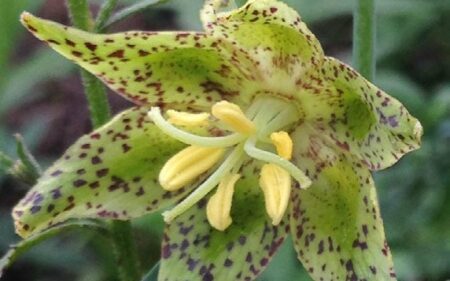The Herbaceous Perennial: Easy to Grow Native Plants
New to the world of native plant gardening? It’s easy to get caught up in the weeds (pun intended) and become overwhelmed with the countless native plant species, varieties, and cultivars available in the trade. Lucky for you, there are several true-and-tried perennial plants that are easy to grow, bloom bountifully, and create habitat.

Perennial plants are plants that live for multiple growing seasons. The plants highlighted here are perennial. Perennial plants can be green and fleshy (herbaceous), semi-woody, or woody. The perennial plants highlighted here grow below five feet, with some spreading via rhizomes (underground vegetative stems) to carpet an area.
Perennial plants can serve many functions in the garden. They lend themselves well for adding color to the landscape and attracting wildlife to the garden, such as this Variable Checkerspot butterfly on golden yarrow (Eriophyllum confertiflorum). A carefully curated selection of flowering perennial plants provides year-round color, refuge for beneficial pollinators, and a sense of place in the California landscape. With some perennial plants living longer than others, lifespan, garden placement, and plant combinations are an integral component of garden design.
The Mixed Perennial Border

Using perennial flowering plants at the front of a planting bed or near a path is a great way to create a space that is inviting for humans and our nonhuman neighbors. As most perennial flowering plants are fast-growing, their inclusion in the native plant garden is a great way to add seasonal color, especially in between slower-growing shrubs. Pictured at Santa Barbara Botanic Garden’s front entrance, the Wayne Roderick Seaside Daisy (Erigeron ’WR’) is a stalwart perennial for Santa Barbara gardens and the Central Coast. In peak bloom from spring to summer, the daisy-like lavender flowers are an important source of nectar and pollen for beneficial pollinators. Plant with California poppy (Eschscholzia californica) and other low growing perennials, including native bunchgrasses.
Perennial Native Plants for Mixed Borders (click the name to view more)
- Electric Blue Foothill Penstemon (Penstemon heterophyllus ‘Electric Blue’)
- Red-flowered Buckwheat (Eriogonum grande var. rubescens)
- Gumweed (Grindelia stricta var. platyphylla)
- San Bruno Mountain Golden Aster (Heterotheca sessiflora ‘San Bruno Mountain’)
- Island Pink Yarrow (Achillea millefolium ‘Island Pink’)
- Silver Carpet Beach Aster (Corethrogyne filaginifolia ‘Silver Carpet’)
- Deergrass (Muhlenbergia rigens)

Habitat and Wildlife Value
California fuchsia (Epilobium canum), also appropriately known as hummingbird trumpet, is adored by our winged friends and blooms from summer to fall, brightening the landscape during the dog days of summer. Bright red tubular-shaped flowers adorn the plant as we move into the warmer months of the year. Silky-haired seeds are wind-dispersed, encouraging reseeding in the landscape. There are also several cultivars of the species available in the trade that offer different flower colors and growth habits. Catalina fuchsia (Epilobium ‘Catalina‘) is a selection that is taller than the typical horticultural form with silvery foliage. Tolerating full sun to part shade, California fuchsia is an excellent herbaceous perennial to include in the landscape. Cut back to the ground in winter to rejuvenate the plant.

A great companion plant to the California fuchsia is the California goldenrod (Solidago velutina ssp. californica). Goldenrod is a fast-growing perennial that blooms in the summertime. Tiny golden yellow flowers adorn the upright inflorescences. Growing to about three to four feet tall, the goldenrod can spread to form a colony, depending on availability of space and moisture. Use in mixed perennial borders, bioswales, or in meadows with our native bunchgrasses as a natural backdrop.
Perennial Native Plants for Habitat and Wildlife Value (click the name to view more)
- Hummingbird Sage (Salvia spathacea)
- Matilija Poppy (Romneya coulteri)
- Purple Haze Coast Aster (Symphyotrichum chilense ‘Purple Haze’)
Shade and Woodland Gardens

The beauty of our gardens is that we’re all going to have different microclimates and environments, including different sun exposure. There are many perennial plants that will thrive in the shady understory of trees. Sticky monkeyflower (Diplacus longiflorus) is a wonderful perennial that will brighten up shady pockets with bright orange flowers. Growing to a height of three feet and just as wide, this local species shines best when interplanted with other evergreen shrubs and perennials, masking its appearance during summer dormancy. Having a shorter lifespan than most shrubs, this perennial is great for adding seasonal color and interest. Countless cultivars are available that offer a rainbow of colors for the landscape. Preferring well-draining soils, this plant does best when planted on slopes or in rocky soils.
Native coral bells (Heuchera spp.) are stars of the spring garden with bright flowers in springtime. These lush perennials range in size from tiny compact plants to up to three feet tall when in bloom. Use in perennial borders or woodland gardens. Particularly attractive when they are mass planted, consider planting drifts to brighten the understory of coast live oaks (Quercus agrifolia). Water occasionally during the warmer summer months. The Garden has introduced several cultivars of coral bells. Look out for the Canyon Quartet series in the nursery.

Irises (Iris spp.) are another beautiful native plant for use in shady areas. Blooming in early spring, irises offer year-round bright evergreen leaves. One noteworthy species is the Garden’s own horticultural introduction, Canyon Snow iris (Iris ‘Canyon Snow’).
 Donate
Donate




